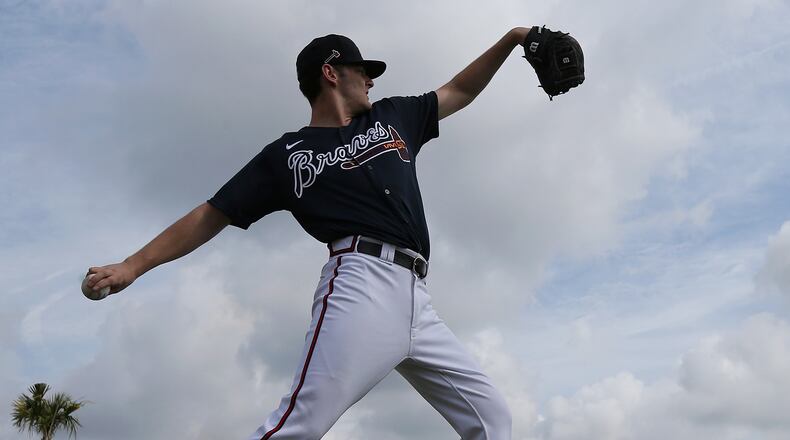Ian Anderson took his turn on the backfield mound on Field 6 at the Braves’ new spring training facility. He was facing third baseman Johan Camargo and zipping pitches to catcher Shea Langeliers.
Whoosh.
Pop.
Phew.
“Atta boy,” yelled animated pitching coach Rick Kranitz after Anderson’s fifth pitch, when he caught Camargo looking for his first strikeout of a 10-minute pitching exhibition.
The sounds of spring are a little mightier when it’s Anderson delivering the ball. Anderson operates with a casual elegance. His unique delivery visually separates him from his colleagues. His latest season statistically pulled him ahead of the pack. His pitch speed is known yet unrecognizable out of the hand.
The Braves’ pitching caravan has at least one more high-level motor in transit. Anderson’s arrival is approaching. Some say this one might deserve the most fanfare of them all. This spring training, his second in big-league camp, might be the last one in which his status is in flux.
At a ripe 21-years old, Anderson is vying for a spot in the Braves’ rotation. The 99% likely outcome is he opens in Triple-A Gwinnett, with his inevitable debut lurking around the nearest corner.
“Absolutely (I’m trying to make the team out of camp),” Anderson said. “That’s the dream and why you play. That’s my goal. To have a good spring and see what happens, put myself in position to make them make a decision.”
Why such ballyhoo for the right-hander? Anderson surpassed lofty expectations a season ago, posting a 2.68 ERA with 147 strikeouts against 47 walks in 111 innings at Double-A Mississippi. He held opponents to a .202 average, second best in the Southern League, and led the league in strikeouts across his 21 starts prior to his promotion to Gwinnett. He'd also logged the eighth-most innings and sixth-best WHIP at 1.16.
While the Braves underwent their reboot — one based around acquiring high quantities of arms — fans clamored for a front-line starter. Early returns suggest they received one in Mike Soroka, who was an All-Star at 21-years old. They might wind up with another in Anderson, who to some evaluators, grades out better than all the team's other recent pitching phenoms.
Credit: Joe Territo
Credit: Joe Territo
The youngster logged just over 24 innings in Triple-A, and had a 6.57 ERA over that span, so let's not begin polishing his plaque just yet. Yet even in a farm system considered the creme de la creme, Anderson offers unparalleled intrigue.
“It’s well deserved,” said Kyle Wright, the team’s No. 2 pitching prospect. “He’s an unbelievable pitcher with unbelievable stuff. I’m really excited for him. I think he’s going to really help us a lot at some point. He pitches well, throws strikes and he’s got a bright future.”
During Wright's final season at Vanderbilt, he hosted Anderson on his official visit, college baseball's recruiting equivalent of Nick Saban's Alabama. The two are reunited with the Braves, hoping what never happened in Nashville will happen roughly four hours south.
“When I first learned about him in high school, I was like ‘Wow this kid’s good. Hopefully we can get him at Vanderbilt,’ ” Wright recalled. “We didn’t, obviously, as he was drafted third overall (Anderson was a Vanderbilt commit). Then watching him pitch in the minors, you see how good he is. He’s got an electric fastball, good off-speed stuff, too. He has an interesting arm angle that makes it really tough to pick up.”
Anderson’s angle cloaks the beginning of his release, giving him a millisecond more advantage. While his mid-90s velocity is well-documented, the ball unexpectedly explodes out of his hand. It’s aided his ability to throw down-and-away strikes, a trait some with the Braves felt was the most advanced they’d seen from a prospect prior to the 2016 draft.
“It’s definitely unique arm slots,” starter Max Fried said. “It’s higher. There aren’t a lot of guys like that. When you have something that’s unique, that not a lot of people have seen or have, you’ll have an advantage. But at the end of the day, it’s about locating your pitches. I’ve played catch with him, we’ve been in the same group at spring training, and everything I’ve seen is really, really good.”
“Ian is one of those games of catch that are a little different,” Soroka said. “A lot of times you’ll go play catch with somebody and you won’t see life on the ball, or you’re wonder where it is, or sometimes they’ll just turn it on when the game’s on. But Ian is one of those special arms where it’s got life. You catch some on the top of your pinkie, really, the first few times he’s getting into one. It’s deception, really. Deception arm speed. That’s why he was taken third overall.”
Anderson’s repertoire also features a power curveball and emerging change-up. He’s working on the finer points of the game, beginning with studying the intricacies of his big-league teammates, down to how they hold baserunners. His command has been mostly sound thus far, though after struggling with the strike zone in Gwinnett, he’ll need to establish consistent control early in the season.
The New York native will continue filling out his listed 6-foot-3, 170-pound frame too. In a clubhouse of behemoths, Anderson has a different physique. While Kyle Muller and Patrick Weigel tower over others, Anderson more so fits in. He looks young, of course, and usually dons glasses and an innocent grin when off the diamond. Think a skinnier Clark Kent who hopes to become Superman on the mound.
“He’s gotten so much bigger, so much stronger the last few years,” Soroka said. “I remember him showing up looking like a beanpole, you know? He’s put in a lot of work too to get where he is today. He’s put on a lot of strength his last couple years of pro ball. He truly is striving to be better every single day. Improving his curveball is a big one to split off his fastball. I know they’re still trying to find which one is better for him to throw, low fastball or high fastball. I think he could be one who does both and that’s pretty special.”
Teammates say Anderson is an eager learner and exceptional listener. Manager Brian Snitker is often giddy speaking on Anderson, always citing his excitement when he takes the mound for a brief spring appearance (he’s made two as of this writing). His intelligence, maturity and talent has captured intrigue in the clubhouse, especially with his ETA accelerating toward Atlanta.
“Very lively arm,” said Tyler Flowers, who caught Anderson’s first bullpen. “First throw, just standing up, I could tell it was coming out a lot faster than it looks like he’s trying to throw. I think most of the guys I’ve run into who have that are pretty successful. So throughout that whole bullpen, his command was tremendous the first 15 pitches. A couple misses, but he made an adjustment to stop missing high arm side. A lot of good signs for a guy’s first bullpen of spring.”
Anderson will spend the bulk of camp with the big-league Braves, getting his feet wet before he embarks on another minor-league trial. The next few weeks will be his final time making an impression on his future teammates and coaches before that day comes.
At one juncture of the 2020 season, the Anderson era will begin. And so will the latest prospect-driven subplot of a Braves pennant chase.
About the Author
Keep Reading
The Latest
Featured



